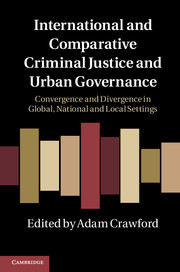 International and Comparative Criminal Justice and Urban Governance
International and Comparative Criminal Justice and Urban Governance from PART 3 - Comparative crime control and urban governance
Published online by Cambridge University Press: 05 June 2011
What has been learned from almost three decades of urban violence in disadvantaged neighbourhoods? The forms of violence conducted by male youths in such areas are frequently conveyed by the media. Places and potentially violent actors are both perceived as risks. Risks rather than feelings of insecurity are what governments want to anticipate. The questions that our era has to confront were hardly confronted before. The political manipulation of risk, threat and danger linked to unknown youths is made easier when mainstream societies lack markers and the necessary distance to deconstruct the fears impacting on their daily life. All over Europe, since 9/11, a noticeable change has been observed among national and local governments advocating principles of precaution and strict policies of identification, surveillance and repression of ‘suspects’. For instance, that the term Muslim has implicitly linked ethnic forms of violence in relegated neighbourhoods and threats of home-grown terrorism in the media rhetoric has allowed ‘entrepreneurs’ to benefit from such representations producing fears, from the media to the security market itself. A new regime order prevails in Europe giving legitimacy to policies of order at the expense of some people's liberties. Such regime's aims are the securisation of territories and the detection of ‘suspects’. But the task being endless, urban governance is taking a leadership role on many aspects, a major one being inclusiveness as a condition of security supported by a preventative approach.
To save this book to your Kindle, first ensure [email protected] is added to your Approved Personal Document E-mail List under your Personal Document Settings on the Manage Your Content and Devices page of your Amazon account. Then enter the ‘name’ part of your Kindle email address below. Find out more about saving to your Kindle.
Note you can select to save to either the @free.kindle.com or @kindle.com variations. ‘@free.kindle.com’ emails are free but can only be saved to your device when it is connected to wi-fi. ‘@kindle.com’ emails can be delivered even when you are not connected to wi-fi, but note that service fees apply.
Find out more about the Kindle Personal Document Service.
To save content items to your account, please confirm that you agree to abide by our usage policies. If this is the first time you use this feature, you will be asked to authorise Cambridge Core to connect with your account. Find out more about saving content to Dropbox.
To save content items to your account, please confirm that you agree to abide by our usage policies. If this is the first time you use this feature, you will be asked to authorise Cambridge Core to connect with your account. Find out more about saving content to Google Drive.